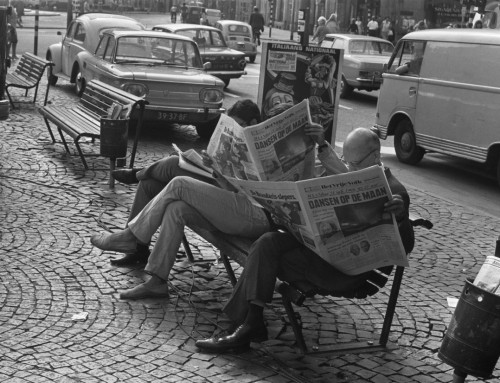When our daughter was about 5 months old I was contacted by the managing salesperson at Remington Rand Typewriter Sales and Service inquiring if I would work for 4 weeks at their office while their receptionist was away on holiday. They were the service company for many offices around the city and I knew him well from my previous position at Ludgate & Ludgate. I agreed to help and during the last week I was there he advised that the Office manager at Cobb & Co Transport asked if he knew of anyone available to work in their office as an administration assistant.
I applied and was interviewed the following Monday. I was offered the position which I accepted and commenced work the following week. My duties there were mainly shorthand and typing correspondence, weekly timesheets and calculating wages for truck drivers and staff as well as some reception duties and answering the telephone when other staff were not available. After a few months another office staff member resigned so I also carried out her work, mainly completing statutory transport department forms and returns. As I had previous experience in taxation forms and related work I prepared the necessary Workers’ Compensation forms.
Occasionally I manned the Cobb & Co Museum which had not long taken shape. It was at the beginnings of what we now have, only a small library style showroom at that time, mainly consisting of early Australiana poems and scripts by many well-known Australian authors together with many pictures and pencil prints hanging around the walls, some works by Toowoomba early settlers and of course some items of early Cobb & Co coaches and equipment from outback travels by the coaches in the mid-1800s to when they ceased operations around the 1940s.
After I had worked there about 10 months, I arrived home from work one afternoon to find Mr. Ludgate waiting for me. He asked if I wanted my old position back at Ludgate & Ludgate as the girl who had replaced me was leaving. He said he would pay me $10.00 a fortnight above my current salary which was a considerable increase at that time. The next day I had an interview with the Cobb & Co management who concluded that I probably wouldn’t stay anyway so I left after 2 weeks.
I was again climbing the stairs at 369 Ruthven Street and took my familiar place at the front desk of the office. All the rooms were the same but some of the staff had left and others had commenced. The two senior accountants I knew, Noel Clark had left to open his own practice and later formed the partnership of Clark & Talbot. He was replaced by Ray Mienert, an older accountant with whom I formed a very special working relationship. He had a very professional work ethic. However to meet him you would consider him to be gruff, but he had a sense of humour and wit second to none, which endeared him to me.
The other senior accountant I had previously worked with was Malcolm Hoey who had moved on to become the Secretary of Defiance Mills. Another accountant had also left to work at Defiance Mills. This is when I first met Allen Whitehouse who had replaced Malcolm as senior accountant and auditor. He was very experienced in company auditing work, being a junior clerk until he qualified as a Chartered Accountant in 1958 with Cooper Brothers Savage & Co (Coopers & Lybrand). He then worked for some years overseas for that company in London and Toronto as auditor until he left, when at the time he was their Audit Manager.
Allen then worked as Queensland Manager for Oil Drilling and Exploration for four years during which time he qualified as an Audit Secretary and Administrator. This brought much experience to our practice and as well, he brought on board most of the employees of the company as taxation clients.
The office procedures had hardly changed from when I left. Wages were still manually prepared and the recording of employees’ yearly wages was still being prepared in wages books recording weekly hours worked and tax deductions calculated. Employers were supplied with Tax Summary Wages Books, consisting of 5 employee sheets to a book. Each sheet was perforated in the centre of the page (one half was affixed to the book and the other half was issued to the employee as their Group Certificate). There was a Summary Sheet at the back of the book and a copy for summarising wages for the year. Each employees’ sheet recorded their weekly wage and tax deductions for the year with a space on the back of each sheet to affix tax deduction stamps.
The stamps were purchased at the Post Office by completing a dissection sheet calculating the stamps required. These stamps had the same value as our currency (being 5c, 10c,20c, 50c, $1,$2,$5,$10, $20 etc.) They resembled ration stamps from war time years, but equal to cash if misplaced. Each stamp came in 2 parts perforated with a larger portion and a smaller portion.
The larger stamp was attached to the employee’s copy of the sheets and the smaller stamp attached to the copy remaining in the book. At the end of each financial year all the sheets were signed by the employer along with the Summaries at the back showing Total Gross Wages and Tax Deductions for the year. Each Group Certificate was removed and given to the employee and the duplicate copy of the Summary Sheet was removed for the employer’s record then the book was sent to the Australian Taxation Office as their record.
A few years later the Taxation Department commenced the PAYG system, as well as issuing employers with a supply of printed Group Certificates in quadruplicate along with Summary Sheets in duplicate. At the end of each financial year the certificates were manually typed. The original and triplicate of the group certificate was issued to the employee. The duplicate copy went to the Tax Office with the original of the Summary sheet and the quadruplicate copy with the copy of the summary was retained by the employer for their record.
We were gradually obtaining more office equipment and were working with upgraded adding machines able to summarise transactions from cheque butts and bank statements as well as photocopying machines able to produce more than one copy and electric typewriters. I was reluctant to upgrade from my reliable manual typewriter with the long carriage but soon realised that this was “the go”.
In the 1960’s and early 1970’s the face of the CBD of Toowoomba had changed dramatically. Some small businesses had closed and stores were relocated. Myer Shopping Centre was built, Pigotts had purchased Palmers Garage building and occupied the adjoining premises to expand into a large department store with entrances in Margaret Street as well as Ruthven Street. Also within the store was a fruit and vegetable section and a café. Some years later they had ceased trading and the store became McDonald & East, but they also closed after a few years and the building was sold.
The Globe Hotel was sold and demolished to become the Heritage Building now Heritage Bank. Cleary & Lee Solicitors, who occupied the Toowoomba Permanent Building Society building, later moved into this building which had access to Margaret Street arcade. Bell Street was closed and became the Bell Street Mall.
This is where we could enter the Australian Taxation Office which had opened up an office in a large building on Bell Street. Centrelink also occupied this building. We were able to lodge forms and correspondence on a daily basis as well as collecting forms and supplies. They later moved to Duggan Street in the Suncorp building but eventually closed the Toowoomba office which meant all documentation was again sent by post to Brisbane. McCaffertys Bus terminal had moved from Margaret Street opposite the Post Office. The Telephone Exchange located behind the Post Office was gone and became Telecom Office in Herries Street. Eagers Retail Pty Ltd was sold to the Holden company and shops were built on the site eventually becoming Gardentown Shopping Centre. Coles department store, which was located next to us, moved to the Myer Shopping Centre and many other hotels, cafes and shops had moved or closed.
Defiance Mills became a Public Company and our office assisted in preparing the Share Certificates for the shareholders.
In 1971 Allen Whitehouse purchased the practice from Mr. Ludgate who retired from accounting, but was still involved in many organisations and for many years often visited the office to have small typing jobs done. A year or so after then, the Australian and New Zealand Bank, being located on the northern side of our office, purchased the building we occupied. The Western Hotel owned by the Tochach family closed the hotel and renovated the building into offices upstairs and small shops on ground level. Mr Michael who operated a well- known drapery and home furnishings business with his family, also closed due to failing health and this area became small shops. He was known for his specials and had a huge following for many years.
So we moved in 1973 into the offices upstairs of the Great Western Building on the corner of Ruthven and Russell Streets. Our offices occupied a large portion of the floor space and we shared the top floor with Hede & Byrne Solicitors and an Insurance Agent who occupied one room. When he left we also used that room for audit staff. Our offices were very much upgraded from 369 Ruthven Street by office space and facilities, air conditioning in some rooms, carpeting throughout with a real kitchen to prepare morning and afternoon teas and the toilets were located on the same floor. The old wooden switchboard was gone and replaced with a new system similar to our current phones, being a main telephone switch with extensions to all offices.
Our work structure of the office had also changed to a great extent as the practice was expanding rapidly and the accounting world was changing to accommodate many more services undertaken in an increasingly competitive world. Our services expanded to Management Consulting, Farm Management, Share and Goodwill Valuations, Body Corporate Management, Insolvencies and Administration Management for Government Indigenous Organisations.
Mr Mienert retired and so other accountants were employed, some stayed with us for a short period leaving for other opportunities in increasing areas of finance accounting and management. Mr. Mienrt still visited us for a chat and a cup of coffee until he passed away in 1987. Two accountants who joined our firm were Bob Pierce and Allen Hertel who remained with us for several years as senior accountants for our clients. Another audit staff accountant moved to Defiance Mills and Alan Davis became the manager of the Audit Section after qualifying as a Chartered Accountant to enable Allen Whitehouse more time for the overall administration management of the practice.
Eventually Allen Whitehouse took Allen Hertel and Alan Davis in as partners into the practice and began trading as Ludgate & Ludgate.
The era of computers was fast approaching and by now we had machines with inbuilt programmes to produce Trial Balances from date entry as well as producing invoices from time sheets and computerised client wages summaries processed by dedicated computer operators.
I can still remember the day when Alan Davis came to me and said we will be introducing computers for each employee. I said “no way am I giving up my electric typewriter” and couldn’t be convinced that a computer could be better. The computers arrived and the partners purchased software called Solution 6 to process all the accounting requirements of Income Tax Returns, Financial Accounts and Group Certificates which would reduce much manual work of paper Tax Returns and wages preparation. I eventually conceded after using the computer that this was “something else” compared to manual book-keeping, so the electric and manual typewriters died a natural death. It was amazing that we could also send messages to other staff members without leaving our desk.
This created a huge work load to enter all the data of every client into the new system and a few of the Administration staff undertook this exercise. By this time I was transferred mainly to the Administration Section as Office Manager assisting Allen Whitehouse and other staff, although I was still involved in preparing some clients’ work, where we managed their affairs and as were previously being prepared by Mr. Mienert.
The Australian Tax Office by now accepted most computerised forms and documents. We would prepare the original and a copy of each return and when approved and signed, these were batched and given to Allen Whitehouse to sign as Tax Agent. The originals then were sent to the Tax Office with a covering letter which listed each client’s return, with the copies filed in our filing room in the clients’ files.
As computer technology continuously expanded to mobile phones and internet communication, this became a brand new way of servicing our clients and in the 1980’s we formed a branch office in Roma after holding seminars there introducing people to the rapid changes occurring in computerised accounting and financial procedures as well as many changes in tax laws and requirements. By the late 1980’s we were also establishing an office at Paddington in Brisbane and I assisted in the setting up of the office and some administrative duties.
As time passed with increasing client work requirements, I was involved more in the Accounting section and another Office Manager was appointed. By then I was more involved in Body Corporate management and preparation of Tax Returns.
The partners presented me with a gift for 30 years’ service, but in 1992 I was required to take some of my sick leave to have a serious operation which resulted in complications and the 4 weeks’ sick leave became 3 months. During this time I am forever grateful for the kindness, care and valued support I received from all the staff and the partners which helped me gain my strength and confidence.







Leave A Comment